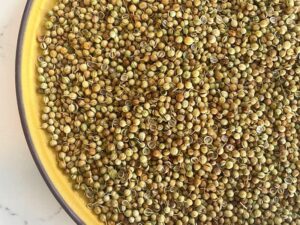Easiest Ways to Substitute Gluten in Your Diet

For years and years, some people had been battling one invisible and sneaky enemy – gluten. Even though the majority don’t have a problem digesting it, an increasing number of people discovered gluten intolerance in the past few years. So, today, the enemy is not that invisible and sneaky, and there are ways to avoid its ”attacks”. If you’ve recently discovered that gluten is your enemy, let’s check out some of the easiest ways to substitute gluten in your diet.
Gluten: what exactly is it?
To avoid your enemy, first, get to know it. Getting to know gluten means getting to know the group of proteins present in:
- wheat
- barley
- rye
- spelt
The Latin word for glue is where the name derives from. In combination with liquid, it makes flour very sticky. Since gluten has a glue-like quality, it can form a sticky network that causes bread to rise when baked. It’s also responsible for bread’s pleasant chewiness.
However, gluten-containing foods may cause gastrointestinal distress in certain persons. Those with celiac disease are at risk for developing severe responses to gluten.
Due to gluten exposure, the immune system of people with celiac disease erroneously assaults healthy tissue. At least 1% of the Western world’s population suffers from celiac disease, which may lead to severe digestive tract damage. So, if you’re one of them, what can you do?
Minimize your intake of processed foods
Gluten is often added to processed foods by manufacturers to enhance chewiness, palatability, and storage stability. There may be hidden sources of gluten in various foods, including lunch meat, sausage, baked goods, french fries, and seasoned rice mixtures.
Additionally, processed gluten-free items tend to have increased fat, sugar, and salt levels. So, although these items do not contain gluten, they may not be a suitable substitute for real food.
Fruits, vegetables, eggs, nuts, and seeds are examples of whole foods that do not contain gluten. Also, they won’t harm your gums and teeth like some gluten-containing products. So, reduce your intake of processed foods and increase your consumption of these healthy foods.
Make gluten-free meal plans
In a world where gluten is everywhere, to avoid it, you’ll need a plan. When you put everything you plan on eating on paper, you’ll see more clearly what can potentially cause problems. That is one of the easiest ways to substitute gluten in your diet. So, make sure to write everything down and check all the dishes for gluten.
Also, gluten intolerance can be an obstacle if you’re undergoing a weight loss program. So, discuss gluten-free meal plans with your nutritionist and a personal trainer. That will help you save time and increase your progress.
Steer clear of gluten in liquids
Since gluten-containing cereals like wheat and barley help make beer, the beverage is a typical way to consume protein. There are gluten-free beers available that use grains like sorghum and rice.
Try something like vodka or gin to satisfy your alcoholic beverage needs while adhering to a gluten-free diet. You can make delicious and classy cocktails from gluten-free products whenever your friends come over!
What about wine, coffee, and smoothies?
In most cases, the wine will not contain any gluten. However, a gluten grain, malt barley, may be included in specific wine coolers.
Gluten is not present in the ingredients of most coffee, tea, and carbonated water brands. Nonetheless, it is advisable to check the label since certain pre-made beverages, including smoothies, coffee drinks, and milkshakes, may contain gluten.
Get back to basics and prepare more meals at home
More and more mainstream dining establishments now offer gluten-free menus. This kind of meal does, however, often come with a higher price tag and a higher chance of contamination.
In addition to improving your health, cutting gluten out of your diet is another health advantage of cooking more meals at home. So, make sure to make your breakfast at home – it will be delicious, and you’ll know what you have put in it.
It’s a cheaper and healthier way of dealing with gluten intolerance
Those who dine at home at least five times per week consume much more fruits and vegetables and have a reduced risk of obesity by 28 percent compared to those who eat at home fewer than three times per week.
To ensure your success, prepare your meals for the week in advance. Gather gluten-free pantry basics like fresh fruits and vegetables, nuts, seeds, legumes, protein sources like eggs and fish, and gluten-free grains.
Find a group of people that share your gluten-free lifestyle
Sometimes those who want to avoid gluten report feeling lonely. It’s not easy when everyone eats the birthday cake, and you need to ask for some more healthy alternatives.
It has been shown that patients with celiac disease are more prone to have psychological difficulties, including isolation, sadness, and social anxiety. When you join a gluten-free group, finding information, community suggestions, and interaction with other individuals with similar food intolerances is much easier.
People living with Celiac disease may find local branches of the National Celiac Association throughout the United States. These local NCA chapters host regional conferences and smaller meetings and provide local support groups.
Final thoughts
Having a gluten intolerance is not easy. It’s an everyday struggle and battle with traditional diets and eating habits. Sometimes, you might fail at eating gluten-free, and you’ll feel the side effects of it. But don’t fret, and don’t give up.
If you incorporate some of these things we mentioned as the easiest way to substitute gluten in your diet, you’ll be one big step closer to a healthier and symptoms-free life. Be consistent, and take your time when you come across obstacles. Remember, your health is your number one






